

Children’s attachment: attachment in children and young people who are adopted from care, in care or at high risk of going into care. This section highlights 3 areas of the children's attachment guideline that could have a big impact on practice and be challenging to implement, along with the reason[s] why we are proposing change in these areas (given in the box at the start of each area).
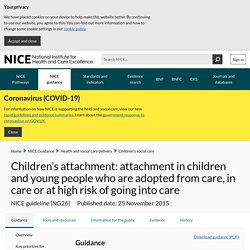
We identified these with the help of stakeholders and Guideline Committee members (see section 9.4 of the manual). The section also gives information on resources to help with implementation. The challenge: stability of care See recommendation 1.1.3. Careasteppingstonetocustody. Main findings: children’s social care in England 2020. Summary This release contains: inspection outcomes for local authority (LA) children’s services inspections from 1 November 2013 covering all inspections published by 30 April 2020 the number of providers of children’s social care, and the number of places they are registered for, as at 31 March 2020 the most recent inspections and outcomes for all regulated and inspected children’s social care provisions, as at 31 March 2020, and published by 30 April 2020 outcomes for all regulated and inspected children’s social care provision inspections carried out between 1 April 2019 and 31 March 2020 and published by 30 April 2020 Due to coronavirus (COVID-19), Ofsted suspended all routine inspections of social care providers on 17 March 2020.
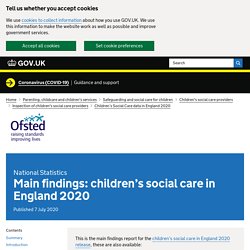
Therefore, we did not complete the inspection cycle and we completed fewer inspections than in previous years as a result. For more information, visit the Ofsted guidance and information relating to COVID-19. Introduction. Emily Johnson 173 Final Thesis new PDF. Care leavers' story: Byron Baker. In one of 17 interviews conducted as part of the Care Leaver's Stories Project, Byron Baker talks about his life before, during and after care.
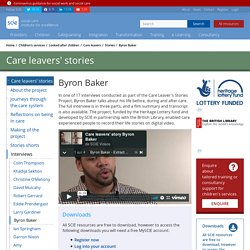
The full interview is in three parts, and a film summary and transcript is also available. The project, funded by the Heritage Lottery fund and developed by SCIE in partnership with the British Library, enabled care experienced people to record their life stories on digital video. Downloads All SCIE resources are free to download, however to access the following downloads you will need a free MySCIE account: Available downloads: Film summary Film transcript. From a distance Looked after children living away from their home area. Adverse Childhood Experiences and Complex Trauma in Looked After Children – CCATS. What is trauma?
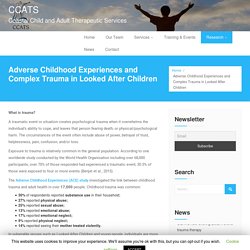
A traumatic event or situation creates psychological trauma when it overwhelms the individual’s ability to cope, and leaves that person fearing death, or physical/psychological harm. The circumstances of the event often include abuse of power, betrayal of trust, helplessness, pain, confusion, and/or loss. Exposure to trauma is relatively common in the general population. According to one worldwide study conducted by the World Health Organisation including over 68,000 participants, over 70% of those responded had experienced a traumatic event; 30.5% of those were exposed to four or more events (Benjet et al., 2015). The Adverse Childhood Experiences (ACE) study investigated the link between childhood trauma and adult health in over 17,000 people. Bibliography and further reading.
Social care commentary: multi-agency safeguarding arrangements. Safeguarding children requires a multi-agency response.

It cannot be done by local authorities alone. This is true across all aspects of safeguarding arrangements: from the frontline practitioner identifying a child at risk and making a referral to the local authority, through to leaders determining local strategic and operational responses to child protection issues. We must get this right for all children who experience abuse or neglect. With the publication of the new ‘Working together to safeguard children’ and local areas moving to new multi-agency safeguarding arrangements for children, this seems an opportune moment to talk about the important factors that we see enabling effective local multi-agency arrangements for safeguarding.
What happens at a strategic level matters. Local authority and children's homes in England inspections and outcomes autumn 2019: main findings. About this release This release covers: inspections and outcomes for local authority children’s services inspections as at 31 August 2019 and published by 30 September 2019 (final data) inspections and outcomes for local authority children’s services inspections between 1 April 2019 and 31 August 2019, published by 30 September 2019 (provisional data) inspections and outcomes of the most recent inspection, for all children’s homes, as at 31 August 2019 and published by 30 September 2019 (final data) inspections and outcomes for all children’s homes between 1 April 2019 to 31 August 2019, published by 30 September 2019 (provisional data) The overall effectiveness of LA children’s services is improving.
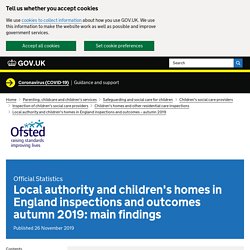
At the end of August 2019, 49% of LAs were judged good or outstanding at their most recent inspection. This is 13 percentage points higher than the proportion judged good or outstanding following each authority’s first inspection under the single inspection framework (SIF). Introduction. Framework evaluation criteria and inspector guidance for the inspection of local authority children s services.
SCH 2019 Text. Children looked after in England 2019 Text. 9.5.3 Protocol for the Working Relationship between the Youth Offending Service and the Children's Social Care. This chapter was extensively revised and updated in October 2017 and should be re-read in full.
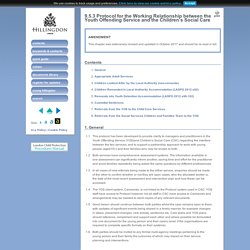
Contents 1. General 2. Appropriate Adult Services See also Appropriate Adult Procedure. 3. 4. See also Remands to Local Authority Accommodation or to Youth Detention Accommodation Procedure. Being charged with a crime: Remand. Youth justice - JUSTICE. Why is youth justice a human rights issue?
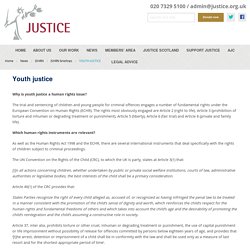
The trial and sentencing of children and young people for criminal offences engages a number of fundamental rights under the European Convention on Human Rights (ECHR). The rights most obviously engaged are Article 2 (right to life), Article 3 (prohibition of torture and inhuman or degrading treatment or punishment), Article 5 (liberty), Article 6 (fair trial) and Article 8 (private and family life).
Which human rights instruments are relevant? As well as the Human Rights Act 1998 and the ECHR, there are several international instruments that deal specifically with the rights of children subject to criminal proceedings. Youth justice - JUSTICE. Looked After Child - Youth Justice Law in England and Wales. 3.12.1 Children Looked After in Contact with Youth Justice Services. Contents 1.

New guidance on looked after children and youth justice - CRAE. The Government has published new statutory guidance on the responsibilities of care planning, placement and case review for looked after children who are in contact with youth justice services.
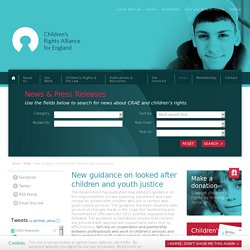
The guidance has been issued to take account of changes made in the Legal Aid, Sentencing and Punishment of Offenders Act 2012 and the regulations that followed. Section 31 – Care Orders – UK Social Services Support. Care orders are sought for a child/ren who Social Services believe are suffering or likely to suffer significant harm. the care of a child is not being what would be expected as reasonable by a parent.the child is beyond parental control No care order can be made on a child who has reached 17 (16 if married). Care Orders last until the child/ren has reached 18 unless discharged earlier. Once courts have made the order they can make interim under under section 38 which gives Social Services parental responsibility and the power to remove the child/ren from their home. Investigations and assessments are to be carried out before any final order is made. Social services will be able to decide who the child/ren live with, and where and who they will be able to see in regards of contact.
Basw 120458 6 0. Children Act Guidance 2015. Legislation Looked After Children. Ukpga 1998 42 contents. Looked After Children and Young People in Contact with Youth Justice Services. This document is only valid 72 hours after printing. Expires 06/05/2020. For the latest version please visit the online manual. Contents 1. Local Authorities should have strategies setting out how they will encourage positive behaviour amongst Looked After children who may be at risk of offending.
Where a Looked After child is thought to be at risk of offending (or reoffending), both the Care Plan / Pathway Plan and the Placement Plan should include details of the support that will be provided to prevent this. The Independent Reviewing Officer (IRO) should ensure that the Care Plan adequately addresses any risk of offending, and should challenge the placing authority where a young person's needs are not being adequately assessed. 2.
Whenever a Looked After child aged under 18 is arrested, the responsible Local Authority should ensure that the young person has the support of an Appropriate Adult and a solicitor while at the police station. Sign in to Outlook. The pains of desistance - 1748895816634812. Local authority use of secure placements. Ukpga 1989 41 section 25. Children’s Social Care in England 2019. This release contains: inspection outcomes for local authority (LA) children’s services inspections from 1 November 2013, covering all inspections published by 30 April 2019 the number of providers of children’s social care, and the number of places they are registered for, as at 31 March 2019 the most recent inspections and outcomes for all regulated and inspected children’s social care provisions, as at 31 March 2019, and published by 30 April 2019 outcomes for all regulated and inspected children’s social care provision inspections conducted between 1 April 2018 and 31 March 2019, and published by 30 April 2019 The overall effectiveness profile of local authorities has improved.
As at 31 March 2019, the proportion of LAs judged good or outstanding for overall effectiveness increased to 46%. After each LA’s first Single Inspection Framework (SIF) inspection it was 36%. The proportion judged inadequate has dropped from 22% after each LA’s first SIF, to 13%. Introduction Notes. Care review full report.
Youth justice statistics bulletin march 2019. Statistics about looked after children. This briefing looks at what data and statistics are available about looked after children to help professionals, and the organisations they work for, make evidence based decisions. Statistics briefing looked after children. Statistics briefing looked after children. Careasteppingstonetocustody. Prisoners childhood family backgrounds. Prisoners childhood family backgrounds. Children looked after in England including adoption: 2018 to 2019. The Protection of Children in England.
Foster Care in England Review. Prisoners childhood family backgrounds. 6.5164 HMI Children in Custody 2017 18 A4 v10 web. Looked After Child (LAC) Policy Analysis. Disclaimer: This work has been submitted by a student. This is not an example of the work produced by our Essay Writing Service. You can view samples of our professional work here. Any opinions, findings, conclusions or recommendations expressed in this material are those of the authors and do not necessarily reflect the views of UK Essays.
In this essay I will be focussing on Looked After Children (LAC) as my service user group and identify relevant laws relating to the service user group and then identify recent policies which underpin this aspect of practice, and discuss the values which underpin the law in this area of practice and finally relate these legislation to my placement practice. Aslam AppliedEdChildPsyD 12. Nuffield Literature review final. Bjsw.bcs007. NikkietalVoRReport2014. Looked after children and offending.
Looked after children and offending: An exploration of risk, resilience and the role of social cognition. Looked after children and offending reducing risk and promoting resilience full report final pdf. Prisoners childhood family backgrounds. Former looked after children in custody. Ukpga 1989 41 section 31. Ukpga 1989 41 section 31. Ukpga 1989 41 contents. Ukpga 2017 16 part 1 chapter 1 crossheading care leavers in england enacted. 10 questions ask if youre ca4. Ukpga 2004 31 contents. Ukpga 2017 16 part 1 chapter 1 crossheading care leavers in england enacted.
The national protocol on reducing unnecessary criminalisation of looked after children and care. Care leavers: Journeys through the care system. Care leavers - what happens when they turn 18? From care to incarceration: The relationship between adverse childhood experience and dysfunctionality in later life. Figures out in June suggest that the number of children being taken into care is at its highest ever.
Last month the children and family courts service received over 1100 care applications, a 25% increase on this time last year. Itself a disturbing statistic, it becomes even more so when looked at in a wider context. A government report from 2002 states that a staggering 49% of children who have been in care will end up in the prison system. They make up 23% of the total prison population. The link between growing up in care and later being incarcerated is only one part of a larger and more complex problem.
The Canadian physician and addiction specialist Gabor Mate claims that only a very small percentage of people who try drugs, including heroin, become addicts. Download the new Independent Premium app Sharing the full story, not just the headlines Norway has the most progressive prison system in the world. Norway is a liberal and progressive society. Children looked after in England 2019 Text. Full report LAC. DFE RR269. Criminal records and young people - never-ending sentences? - Queen's Policy Engagement. Although there is considerable debate about the extent to which youth justice systems are sufficiently differentiated from the adult criminal justice system, the existence of a separate system acknowledges the fact that young people should be treated differently to adults in the criminal justice process.
The Justice Act (NI) (2002) sets out the principles governing the youth justice system in Northern Ireland and includes provisions for the use of youth conferences. Since enactment, restorative based youth conferencing has become the primary mode for dealing with young people in conflict with the law. There are two routes through which a youth conference can take place – either on the direction of the Public Prosecution Service (a so-called ‘diversionary’ conference), or on the direction of the court. One of the underpinning philosophies of restorative justice is to restore the harm caused by offending and the Northern Irish model has been cited as a model of good practice. Conclusion. Half of children in youth custody have been in care system, review finds. Children in care are six times more likely to be cautioned or convicted of a crime than other young people, new research has found.
CCO Advocacy for children June 2019. Looked after children print. In care out of trouble summary. Residential care and criminalisation: the impact of system abuse. HLWP 14 2014. Offending rates among children in care investigated. Sponsor a Child in Latvia. SOS Children's Villages started working in Latvia after the country became independent from the former USSR. In care out of trouble summary. Building Bridges: A Positive Behaviour Framework for the Children and Young People Secure Estate. The national protocol on reducing unnecessary criminalisation of looked after children and care. Care-criminalisation: The involvement of children in out of home care in the NSW criminal justice system — Charles Sturt University Research Output. @phdthesis{f0c95086d05b4ae9a4f610dd3a9e41d8,